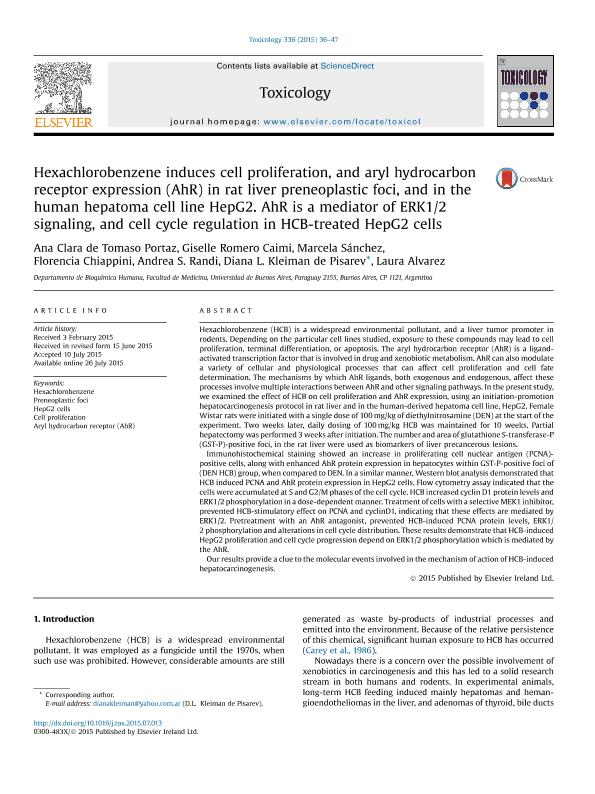Mostrar el registro sencillo del ítem
dc.contributor.author
de Tomaso Portaz, Ana Clara

dc.contributor.author
Romero Caimi, Vanesa Giselle

dc.contributor.author
Sánchez, Marcela
dc.contributor.author
Chiappini, Florencia Ana

dc.contributor.author
Randi, Andrea Silvana

dc.contributor.author
Kleiman, Diana Leonor

dc.contributor.author
Alvarez, Laura

dc.date.available
2020-09-17T20:35:50Z
dc.date.issued
2015-10
dc.identifier.citation
de Tomaso Portaz, Ana Clara; Romero Caimi, Vanesa Giselle; Sánchez, Marcela; Chiappini, Florencia Ana; Randi, Andrea Silvana; et al.; Hexachlorobenzene induces cell proliferation, and aryl hydrocarbon receptor expression (AhR) in rat liver preneoplastic foci, and in the human hepatoma cell line HepG2. AhR is a mediator of ERK1/2 signaling, and cell cycle regulation in HCB-treated HepG2 cells; Elsevier Ireland; Toxicology; 336; 10-2015; 36-47
dc.identifier.issn
0300-483X
dc.identifier.uri
http://hdl.handle.net/11336/114258
dc.description.abstract
Hexachlorobenzene (HCB) is a widespread environmental pollutant, and a liver tumor promoter in rodents. Depending on the particular cell lines studied, exposure to these compounds may lead to cell proliferation, terminal differentiation, or apoptosis. The aryl hydrocarbon receptor (AhR) is a ligand-activated transcription factor that is involved in drug and xenobiotic metabolism. AhR can also modulate a variety of cellular and physiological processes that can affect cell proliferation and cell fate determination. The mechanisms by which AhR ligands, both exogenous and endogenous, affect these processes involve multiple interactions between AhR and other signaling pathways. In the present study, we examined the effect of HCB on cell proliferation and AhR expression, using an initiation-promotion hepatocarcinogenesis protocol in rat liver and in the human-derived hepatoma cell line, HepG2. Female Wistar rats were initiated with a single dose of 100. mg/kg of diethylnitrosamine (DEN) at the start of the experiment. Two weeks later, daily dosing of 100. mg/kg HCB was maintained for 10 weeks. Partial hepatectomy was performed 3 weeks after initiation. The number and area of glutathione S-transferase-P (GST-P)-positive foci, in the rat liver were used as biomarkers of liver precancerous lesions.Immunohistochemical staining showed an increase in proliferating cell nuclear antigen (PCNA)-positive cells, along with enhanced AhR protein expression in hepatocytes within GST-P-positive foci of (DEN HCB) group, when compared to DEN. In a similar manner, Western blot analysis demonstrated that HCB induced PCNA and AhR protein expression in HepG2 cells. Flow cytometry assay indicated that the cells were accumulated at S and G2/M phases of the cell cycle. HCB increased cyclin D1 protein levels and ERK1/2 phosphorylation in a dose-dependent manner. Treatment of cells with a selective MEK1 inhibitor, prevented HCB-stimulatory effect on PCNA and cyclinD1, indicating that these effects are mediated by ERK1/2. Pretreatment with an AhR antagonist, prevented HCB-induced PCNA protein levels, ERK1/2 phosphorylation and alterations in cell cycle distribution. These results demonstrate that HCB-induced HepG2 proliferation and cell cycle progression depend on ERK1/2 phosphorylation which is mediated by the AhR.Our results provide a clue to the molecular events involved in the mechanism of action of HCB-induced hepatocarcinogenesis.
dc.format
application/pdf
dc.language.iso
eng
dc.publisher
Elsevier Ireland

dc.rights
info:eu-repo/semantics/openAccess
dc.rights.uri
https://creativecommons.org/licenses/by-nc-sa/2.5/ar/
dc.subject
HEXACLOROBENCENO
dc.subject
PROLIFERACIÓN CELULAR
dc.subject
RECEPTOR DE HIDROCARBUROS AROMÁTICOS
dc.subject
HIGADO DE RATA
dc.subject
FOCOS PRENEOPLASICOS
dc.subject
CÉLULAS HEPG2
dc.subject
ERK1-2
dc.subject
CICLO CELULAR
dc.subject.classification
Toxicología

dc.subject.classification
Medicina Básica

dc.subject.classification
CIENCIAS MÉDICAS Y DE LA SALUD

dc.title
Hexachlorobenzene induces cell proliferation, and aryl hydrocarbon receptor expression (AhR) in rat liver preneoplastic foci, and in the human hepatoma cell line HepG2. AhR is a mediator of ERK1/2 signaling, and cell cycle regulation in HCB-treated HepG2 cells
dc.type
info:eu-repo/semantics/article
dc.type
info:ar-repo/semantics/artículo
dc.type
info:eu-repo/semantics/publishedVersion
dc.date.updated
2020-09-08T13:59:00Z
dc.journal.volume
336
dc.journal.pagination
36-47
dc.journal.pais
Irlanda

dc.description.fil
Fil: de Tomaso Portaz, Ana Clara. Universidad de Buenos Aires. Facultad de Medicina. Departamento de Bioquímica Humana. Cátedra de Química Biologica; Argentina. Consejo Nacional de Investigaciones Científicas y Técnicas. Oficina de Coordinación Administrativa Houssay; Argentina
dc.description.fil
Fil: Romero Caimi, Vanesa Giselle. Universidad de Buenos Aires. Facultad de Medicina. Departamento de Bioquímica Humana. Cátedra de Química Biologica; Argentina
dc.description.fil
Fil: Sánchez, Marcela. Universidad de Buenos Aires. Facultad de Medicina. Departamento de Bioquímica Humana. Cátedra de Química Biologica; Argentina
dc.description.fil
Fil: Chiappini, Florencia Ana. Consejo Nacional de Investigaciones Científicas y Técnicas. Oficina de Coordinación Administrativa Houssay; Argentina. Universidad de Buenos Aires. Facultad de Medicina. Departamento de Bioquímica Humana. Cátedra de Química Biologica; Argentina
dc.description.fil
Fil: Randi, Andrea Silvana. Universidad de Buenos Aires. Facultad de Medicina. Departamento de Bioquímica Humana. Cátedra de Química Biologica; Argentina. Consejo Nacional de Investigaciones Científicas y Técnicas. Oficina de Coordinación Administrativa Houssay; Argentina
dc.description.fil
Fil: Kleiman, Diana Leonor. Universidad de Buenos Aires. Facultad de Medicina. Departamento de Bioquímica Humana. Cátedra de Química Biologica; Argentina. Consejo Nacional de Investigaciones Científicas y Técnicas. Oficina de Coordinación Administrativa Houssay; Argentina
dc.description.fil
Fil: Alvarez, Laura. Universidad de Buenos Aires. Facultad de Medicina. Departamento de Bioquímica Humana. Cátedra de Química Biologica; Argentina. Consejo Nacional de Investigaciones Científicas y Técnicas. Oficina de Coordinación Administrativa Houssay; Argentina
dc.journal.title
Toxicology

dc.relation.alternativeid
info:eu-repo/semantics/altIdentifier/url/http://www.sciencedirect.com/science/article/pii/S0300483X15300135
dc.relation.alternativeid
info:eu-repo/semantics/altIdentifier/doi/http://dx.doi.org/10.1016/j.tox.2015.07.013
Archivos asociados
